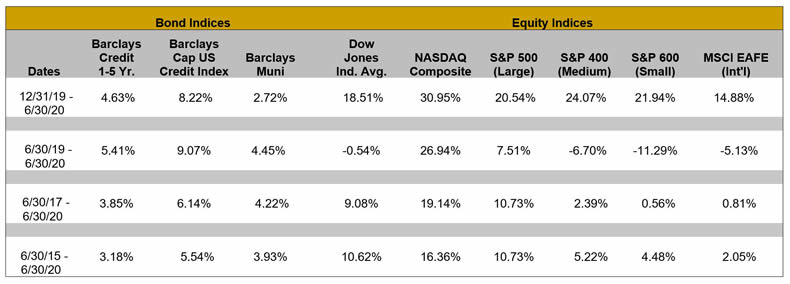Investment Management - Second Quarter 2020
We provide a copy of our investment management letter, without enclosures, to keep you up-to-date on the investment markets and West Financial Services.i
The Comeback Kid
Who doesn’t love a great comeback story? This type of narrative usually occurs after the protagonist experiences some type of hardship and all hope appears lost. Then, out of the blue, an event ensues that reenergizes the main character. In this tale, COVID-19 is the hardship, global central banks are the event, and the stock market is truly a Comeback Kid — and come back it did!
Equity markets experienced a substantial rebound during the second quarter with the large capitalization S&P 500 delivering a total return of 20.54%. The index was driven higher by technology companies, many of which benefitted from people working from home. Mid and small caps jumped 24.07% and 21.94%, respectively. International stocks, tracked by the MSCI EAFE, rose 14.88%. Overseas equities continue to underperform their domestic counterparts largely due to the lack of technology companies such as Apple, Amazon, and Microsoft.
Performance provided by Morningstar for various indices for the year-to-date (not annualized), one-year, three-year, and five-year periods appears below:

Remember the hardship. A double whammy of COVID-19 and crashing oil prices sent global stock and fixed income markets into a tailspin. The uncertainty of the economic impact was so severe, oil prices dipped below zero and one could not receive a bid for even the safest bond. Then, from out of the darkness, the Federal Reserve (“Fed”) and U.S. government sprang into action. They lowered interest rates, announced asset purchases, payments to individuals, and federally guaranteed small business loans. While markets appreciated the rapid response time, it was the dollar amount relative to U.S. GDP that provided the shock and awe investors needed to re-engage with risk assets.
And now the battle rages. The dilemma market participants are facing is that it’s extremely difficult to forecast the exact path and pace of the recovery. During the latest earnings season, due to limited visibility, most companies pulled their annual guidance. This makes forecasting corporate profits even more hazardous than usual. Equity investors are optimistic that the stimulus provided, along with reopening the economy, will bring about a “V”-shaped, or quick recovery. News of improved treatment options along with progress on a vaccination will also assist in saving the day.
On the other hand, several southern and western states are halting or reversing the path of reopening as they experience an increase in COVID-19 cases. These closures will likely hurt employment in the coming months. Meanwhile, spending has held up due to increased unemployment payouts, which expire at the end of July. If these payments are not extended, spending power could be dented and force an elongated path of recovery. Finally, while people are anxious to leave their homes, if they don’t feel safe, the re-opening of the economy will slow.
To avert that scenario, the government remains ready. One particular segment of the original stimulus response included the Fed buying both individual and corporate bond ETFs. What has been good for the overall bond market in terms of liquidity, has not been good in terms of the availability of bonds for purchase. Investment grade corporate issuance has hit a record of over $1 trillion this year, double the pace of last year. Companies are issuing debt at a record pace to stock-pile cash to weather the crisis and take advantage of extremely low interest rates. However, the new issuance has not benefitted most investors. As of June 16, the government has purchased $6.8 billion of corporate bond ETFs. Investors across the globe are also looking for safe-havens, the last week of May saw $7.5 billion flow into investment-grade bond funds. This enormous demand has dramatically decreased the inventory of bonds we normally see, as governments, institutions, and investors all chase the same quality bonds.
Fixed income investors are also dealing with unprecedented low yields. Federal Reserve Chairman Powell and the Federal Open Market Committee (“FOMC”) have stated they expect the fed funds rate to remain at 0% at least until the end of 2022, or in their words, “As long as it takes.” Currently, prices of highly rated, short-term bonds, have risen to a point where the bonds are trading with negative yields. New issues of BBB-rated bonds with five year maturities have yields of approximately 1.3%.
Inflation is a factor in interest rates. Near term, demand destruction from the loss of jobs has lowered inflation. The Fed’s preferred measure of inflation, the PCE Index, is just one-half of 1%. The break-even point between a 10-year Treasury bond and a 10-year TIP (Treasury Inflation Protected bond) is zero, implying little to no inflation for the next ten years. While inflation may be low for the near-term, economic reacceleration and FOMC policy that is slow to remove accommodations could result in elevated levels of inflation in the later-half of the decade.
At WFS, the fixed income allocation is considered the safe portion of the portfolio. Bonds are purchased to provide ballast to the portfolio, with the goal of providing income and return of principal. Despite the lack of income on new bond purchases, accounts with an allocation to fixed income have seen volatility significantly reduced so far this year. We are not comfortable with the risk-reward tradeoff in purchasing long-term bonds in most circumstances, so we are generally keeping our purchases short at 1 to 3 years during the current situation.
As we continually assess the landscape, the case can be made for holding equity allocations above target for clients who have longer investment time horizons. Boosting equities should increase the total return of the portfolio, though it will be associated with higher volatility, which we expect to continue given the virus and upcoming presidential election. Longer time horizons provide the ability to recover should equity markets experience another significant decline. It is important to periodically review your asset allocation, in light of unprecedented circumstances, to maintain an appropriate balance between your risk tolerance, time horizon, and portfolio goals. Please contact us if your circumstances have changed.
Enclosed you will find your portfolio appraisal as of June 30, 2020. We have provided performance numbers for the year-to-date, one-year, three-year, and five-year periods, where applicable. Also enclosed you will find our Client Relationship Summary (“Form CRS”), which was recently filed with the Securities and Exchange Commission. Form CRS details the services we provide, fees we charge, and other information about the firm. If you have questions about this document, please contact us. Lastly, we have included our annual Privacy Notice, stating our policy on the confidentiality of client information. If you wish to opt out of sharing information, other than that which is required by law, please complete the form and mail it to the West Financial or the Sandy Spring Bank address provided on the form. If you prefer, you may also opt-out by calling the number listed on the Privacy Notice.
In April, West Financial was named by Investment News “One of the Best Places to Work for Financial Advisers”.ii This is our third consecutive year to receive this recognition.
Referrals of family, friends and colleagues who may benefit from financial planning and investment management guidance are always welcome. Thank you for recommending our firm and your continued trust in our financial planning and investment management services.
|
President
|
Chief Investment Officer
|
Director of Fixed Income
|
|---|---|---|
 |
 |
 |
| Glen J. Buco, CFP® | Glenn Robinson, CFA | Norma Graves, CFP® |
West Financial Services, Inc. offers investment advisory services and is registered with the U.S. Securities and Exchange Commission (“SEC”). SEC registration does not constitute an endorsement of the firm by the SEC nor does it indicate that the firm has attained a particular level of skill or ability. You should carefully read and review all information provided by WFS, including Form ADV Part 1A, Part 2A brochure and all supplements, and Form CRS. The information contained herein does not constitute investment advice or a recommendation for you to purchase or sell any specific security. You are solely responsible for reviewing the content and for any actions you take or choose not to take based on your review of such content.
This information is intended to be educational in nature, and not as a recommendation of any particular strategy, approach, product or concept. These materials are not intended as any form of substitute for individualized investment advice. The discussion is general in nature, and therefore not intended to recommend or endorse any asset class, security, or technical aspect of any security for the purpose of allowing a reader to use the approach on their own.
Certain information contained herein was derived from third party sources as indicated. While the information presented herein is believed to be reliable, no representation or warranty is made concerning the accuracy of any information presented. We have not and will not independently verify this information. Where such sources include opinions and projections, such opinions and projections should be ascribed only to the applicable third party source and not to West Financial Services, Inc.
Certain statements herein reflect projections or opinions of future financial or economic performance. Such statements are “forward-looking statements” based on various assumptions, which may not prove to be correct. No representation or warranty can be given that the projections, opinions, or assumptions will prove to be accurate.
iEach of the S&P 500 Index, the S&P 400 Index, the S&P 600 Index, the MSCI EAFE Index, the Barclays Credit 1-5 Year Index, the Barclays Cap U.S. Credit Index, the Barclays Capital Municipal Bond Index, the Dow Jones Industrial Average, and the NASDAQ Composite (each, an “Index”) is an unmanaged index of securities that is used as a general measure of market performance. The performance of an Index is not reflective of the performance of any specific investment. Each Index comparisons is provided for informational purposes only and should not be used as the basis for making an investment decision. Further, the performance of your account and each Index may not be comparable. There may be significant differences between the characteristics of your account and each Index, including, but not limited to, risk profile, liquidity, volatility and asset comparison. The performance shown for each Index reflects no adjustment for client additions or withdrawals, and no deduction for fees or expenses. Accordingly, comparisons against the Index may be of limited use. Investments cannot be made directly into an Index.
iiIn order for firms to be considered for InvestmentNews’ list of Best Places to Work for Financial Advisers, the firm must meet the following criteria: (1) be a registered investment adviser or an affiliated independent broker-dealer; (2) be in business a minimum of one year; and (3) have at least 15 employees. The firm must register with INBestPlacestoWork.com and complete a survey that asks questions about the firm’s working environment, benefits, company culture and other key areas. The survey was developed by an outside consultant with the input of InvestmentNews and leading industry executives. Once the survey is completed, employees are invited to fill out a survey that will focus on what they really love about working at the participating firm. InvestmentNews consultants then independently combine the two surveys and come up with a final score that determines whether the firm will be named one of the Best Places to Work for Financial Advisers. Firms do not pay a fee to be considered or placed on the final list of Best Places to Work for Financial Advisers. The only cost is to allow participating firms to view the employee feedback reports.
|
|


